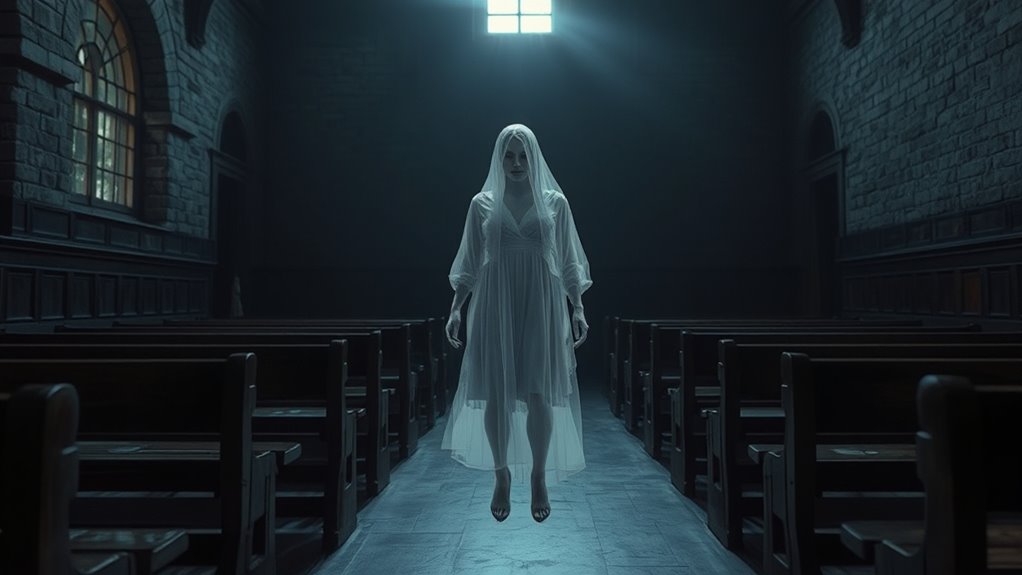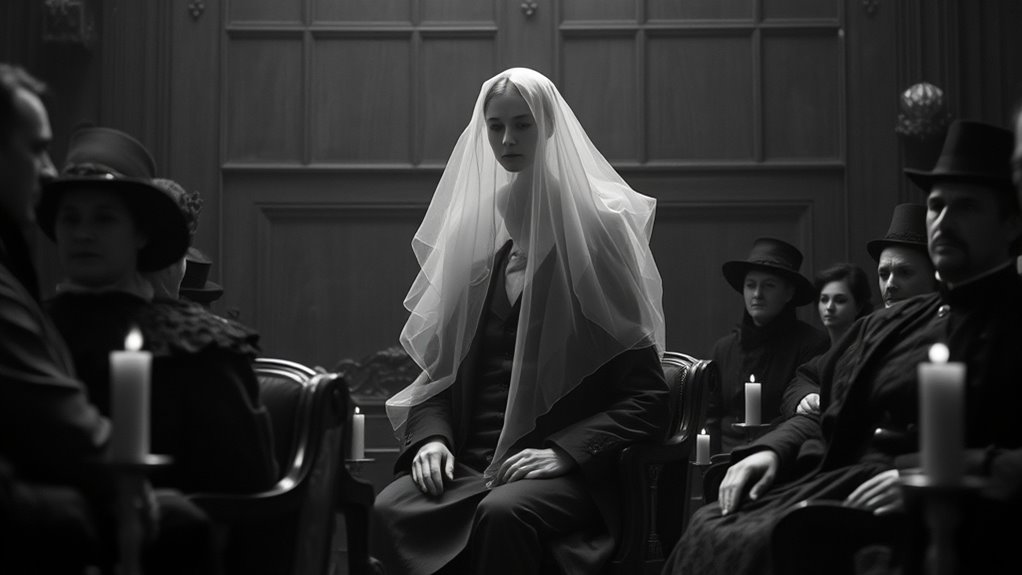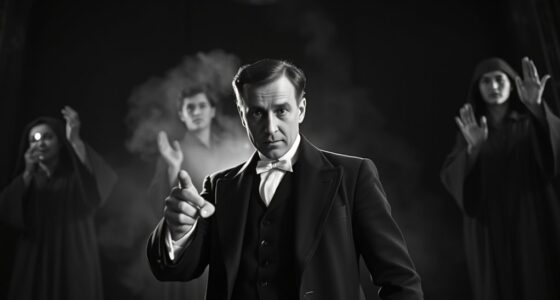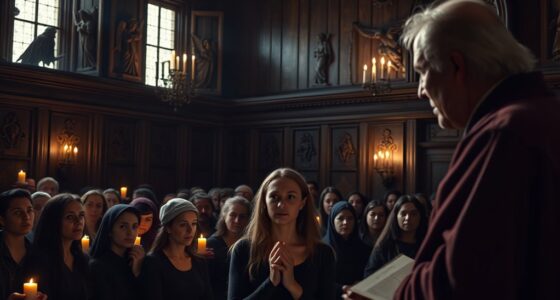The Greenbrier Ghost tells how a woman’s spirit influenced her 1897 murder conviction in West Virginia. Her mother claimed to see her ghost, revealing hidden details about her death that convinced the court of her husband’s guilt. This case challenges traditional ideas about evidence, showing how supernatural beliefs can impact justice. Curious to see how this haunting story shaped legal history? Keep exploring to learn more about this extraordinary case.
Key Takeaways
- The Greenbrier Ghost case involved Zona Heaster Shue’s murder in 1897, with her mother claiming her ghost revealed details leading to the conviction.
- Zona’s mother testified that her ghost appeared and explained her death, influencing the court’s decision to convict Trout Shue.
- The case is notable for its acceptance of supernatural testimony as credible evidence in a legal trial.
- It challenged traditional legal norms and sparked ongoing debates about the legitimacy of paranormal evidence in court.
- The case remains a significant example of how cultural beliefs and supernatural influences can impact judicial outcomes.

Have you ever heard of a ghost influencing a murder conviction? If not, the story of the Greenbrier Ghost might surprise you. It’s a case where a spirit’s testimony played a pivotal role in the legal history of West Virginia. In 1897, the murder of Zona Heaster Shue became one of the most unusual cases of its time, mainly because the evidence came from beyond the grave. You see, after Zona’s death, her mother claimed to have seen her ghost, who revealed details about her murder. This ghostly witness convinced the local community and, ultimately, the court that Zona’s husband, Trout Shue, was responsible for her death. The case remains notable for its influence on legal history and how supernatural beliefs affected the justice process.
What makes this case even more fascinating is how it influenced the legal process. At that time, paranormal investigation was not a recognized part of courtroom proceedings, but Zona’s mother’s account, backed by her own conviction, was enough to sway the jury. Her insistence that Zona appeared to her, explaining how Trout had killed her, challenged the norms of legal history. The court didn’t dismiss the ghost story outright; instead, it regarded the testimony seriously enough to convict Trout of murder. This case remains an early example of how Supernatural evidence intersected with legal procedures, prompting discussions about the boundaries of admissible evidence. Additionally, this case exemplifies how cultural beliefs can influence judicial outcomes.
Zona’s mother’s conviction based on her ghostly testimony challenged legal norms and influenced courtroom perceptions.
The story of the Greenbrier Ghost highlights how paranormal investigation, even in its most informal form, can influence a criminal case. The mother’s unwavering belief in her daughter’s spirit and her insistence that the ghost’s testimony was crucial evidence led to Trout’s conviction. Though some dismiss it as superstition, others see it as a testament to the power of conviction and the influence of cultural beliefs on justice. This case left a lasting mark on legal history, illustrating that sometimes, the testimony of a spirit can sway the outcome of a trial more than physical evidence. It also prompted discussions about the boundaries of admissible evidence and the role of supernatural phenomena in courtrooms. Moreover, this case demonstrates how supernatural testimony can challenge the conventional understanding of legal evidence.
Furthermore, the case exemplifies how societal context and cultural beliefs can shape perceptions of truth and justice, influencing judicial decisions in ways that extend beyond empirical proof. Today, the Greenbrier Ghost remains a fascinating example of how the paranormal has historically been intertwined with the legal process. It challenges us to consider whether truth is only what can be physically proven or if belief and testimony—whether from the living or from beyond—can also influence justice. As you examine the case, you might see it as an early form of paranormal investigation that shaped legal history, reminding us of the complex relationship between the supernatural and the pursuit of truth in the courtroom. This story continues to inspire debates on the legitimacy of supernatural influence in legal settings and how cultural context shapes judicial decisions.
Frequently Asked Questions
How Did the Ghost’s Testimony Influence West Virginia Law?
You see, the ghost’s testimony deeply influenced West Virginia law by highlighting the spiritual influence on legal proceedings. It prompted legal reforms by encouraging courts to reconsider how evidence, even supernatural ones, could be interpreted. This case challenged traditional boundaries and opened discussions about the legitimacy of such testimony, ultimately leading to a more flexible legal approach that acknowledged spiritual influence in courtrooms.
Were There Other Similar Cases Involving Ghost Testimonies?
You’re curious if other cases used supernatural evidence like ghost testimonies. While rare, some courts have considered supernatural evidence, but it rarely influences legal precedents due to scientific skepticism. The Greenbrier Ghost remains unique because it set a precedent for accepting ghost testimony in court, leading some to question how supernatural evidence might challenge legal standards. Overall, such cases are exceptional and not widely accepted in modern law.
What Was the Public’s Reaction to the Ghost’s Court Appearance?
You might be surprised by the public’s reaction to the ghost’s court appearance, which sparked both fascination and skepticism. Many people believed it, embracing the supernatural, while others dismissed it due to widespread media sensationalism and prevailing supernatural skepticism. The case challenged traditional views, prompting debates about the supernatural’s role in justice. Overall, it drew intense media attention, exposing contrasting opinions and fueling ongoing discussions on the legitimacy of ghostly testimonies.
How Did the Family of the Victim React After the Trial?
Imagine a tree shaken by a storm; its roots, once firm, now tremble with grief. After the trial, your family feels this profound loss, yet finds strength through community support. They mourn deeply, but the community’s compassion helps soothe their sorrow. Family grief remains, but shared understanding begins to rebuild their hope, like new leaves sprouting amid the storm’s aftermath, restoring their faith in justice and healing.
Are There Any Modern Cases Inspired by the Greenbrier Ghost?
You might be surprised to learn that modern cases inspired by the Greenbrier Ghost do exist, especially in the domain of spiritual investigations. These cases often challenge legal precedents by introducing supernatural elements as evidence. While courts typically remain skeptical, some investigators believe that the Greenbrier Ghost set an early precedent for considering spiritual testimony, prompting ongoing debates about the role of the supernatural in legal proceedings today.
Conclusion
As you step back from this ghostly tale, you realize that the Greenbrier Ghost’s story isn’t just a whisper from the past — it’s a thunderclap echoing through history, shaking the very foundations of justice. Her spirit’s testimony, more powerful than a hurricane, proves that sometimes, the truth can rise from the dead and turn a courtroom into a battlefield of supernatural proportions. Truly, her story is an everlasting storm in the calm sea of the legal world.









